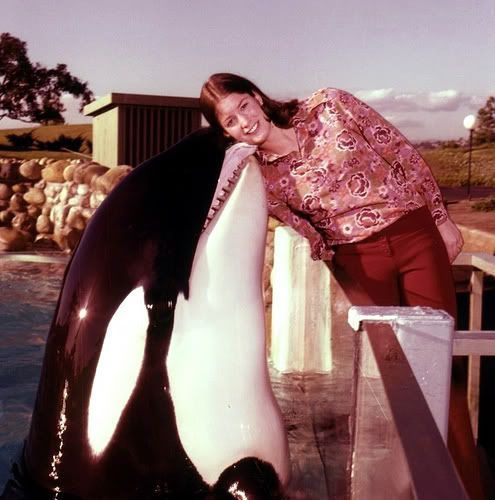
Above: Vintage orca photo of something not done much these days.
Orcinus orca is a beautiful and majestic animal but the species also hunts and kills with skill and innovation.
Basically, beauty and beast combine into one powerful predator known as the killer whale or orca.
Tilikum made headlines all over the world when he killed orca trainer Dawn Brancheau.
What disturbed me about this incident was that all of the mainsteam media commentaries got out of hand and most of those comments, with the exception of one, were made by people who had not seen the footage of the killer whale incident.
It used to be that you could rely on the news anchors to have some sort of journalist ethics but today those seem to be sadly missing in mainstream media and have been replaced with personal opinions and commentaries spouted carelessly in a variety of mediums.
Hopefully we won’t see the footage of the orca attack and I guess I should not be surprised that the media would seek legal avenues to get their hands on it.
But aren’t there are more important things going on in the world above and beyond the morbid fascination of one person’s death by a captive predator?
Anyway I was shaking my head over comments such as:
- Tilikum was only playing.
- Sea World’s killer whale mistook the orca trainer’s pony tail for a novel object (toy).
- It was the trainer’s fault that she was attacked.
- Wild killer whales have never attacked a human.
Okay, so consider why I think all of those statements are cr**:
Tilikum was only playing: Most professionals worth their salt would question this statement. First, you have to ask why we have not seen play behavior like this before? Also, the reference the expert made was actually about footage of a killer whale “toying” with seals it was hunting.
Sea World’s killer whale mistook the orca trainer’s pony tail for a novel object (toy): Because this trainer had worked with Tilikum for some time, with the same hair length, I question this statement. Yes, some species will grab what they can—hair decorations, jewelry, etc., but to believe this animal did not recognize or distinguish this element of his trainer’s appearance is not something that rings true. Plus, I have to ask—did he really grab her pony tail?
It was the marine mammal trainer’s fault that she was attacked: First, to make that statement on national television when no investigation had been done was irresponsible. But in my experience, in many cases, captive animal incidences are related to human error or equipment failure. For instance, a human goes into an environment of a predator that is not trained to accept that and gets killed. So, I don’t categorize this incident as trainer error in that respect–but unless we see the video all we can do is speculate and wait for the investigation to conclude. The killer whale trainer was on the slide out (a shallow platform where animals can slide out in a few inches of water) and just what positioning and proximity to the animal was protocol or not remains to be revealed.
Wild killer whales have never attacked a human so this is abnormal behavior: This is something that a lot of people want to believe but it isn’t true. In fact, how many wild orca incidents do we not know about? I have to also say that the public and OSHA only see the captive incidents that are reported or result in injury.
Medical Examiner’s Report
Now, I’d like to share a few statements from the medical examiner’s report to remove any illusions you might have about it.
I’ve read and have a copy of the final autopsy that states the killer whale trainer died as the result of drowning and traumatic injuries.
The autopsy report reveals that her spinal cord was fractured and that her body was covered in cuts and bruises.
Avulsion is the polite medical term for a ripping or tearing of the skin or body part (like from bites) and the report identifies areas with that type of injury and also blunt force trauma injuries.
The summary?
Multiple fractures to her back, ribs, legs, arms and face. The left arm was torn off along with part of her scalp.
Granted, a 12,300 pound mammal packs a lot of power, and perhaps you’ve seen other footage of other orca trainers that have been knocked around by killer whales, but I’ve seen orcas go after their trainers lots of times–and my point is that most are not dead.
In fact, why we don’t see more of these types of incidents is probably due to the fact that animal trainers are humans (who are land animals) and spend very little time in the same environment as the captive killer whales.
Remember that he grabbed her.
In an article published at USA Today, Mike Wald, a spokesman for OSHA’s Southeast Region talked with reporters.
USA today perused records and believes that state and federal records shows similar patterns of orca behavior in earlier incidents on other trainers—it sure would be nice to see the citations.
In my past research, I’ve also seen lower level incidents prior to escalated ones–but not always.
Toy or Predator?
One of the big frustrations in the animal profession stem from the gross misunderstanding as to who and what animals (of all types) are really like.
In fact, the Daniel P Duke family (he was killed in 1999–see below) actually sued Sea World, alleging the dangerous orca was portrayed as a huggable stuffed toy. (The lawsuit was quickly dropped.)
People want to believe that wild creatures are benevolent to humans and so tend to anthropomorphize (attribute human traits and motivations to them) instead of understanding the real animal and their animal nature.
Motion pictures and theme parks don’t help and perpetuate some of those illusions.
The fact of the matter remains–killer whales are adept predators. (I know you must be sick of hearing this from me but seriously, humans need to get that into their skulls.)
Killer whales kill things to eat, experiment with hunting strategies, and use their brains to help them to adapt better ways to dispatch their prey.
Tilikum the Killer Whale
Tilikum was captured in Iceland in November of 1983 and delivered to, the now defunct, Sealand of Pacific in Victoria, British-Columbia.
Today he resides at Sea World of Florida and is the largest killer whale in captivity (22 feet and 12, 300 pounds).
He can be recognized by his dorsal fin which has folded over and also from two thin, small black markings on both his eye patches.
This orca is also know by his associaton with two other fatal incidents.
In case you are not familiar with this animal’s history, here are the three main incidents we know about:
February 21, 1991: A part-time marine mammal trainer fell into the orca tank at Sealand of the Pacific in British Columbia, Canada. At that time trainers were not allowed in the water with the whales. The three whales grabbed, thrashed, and submerged 20-year-old female trainer Keltie Byrene until she was dead. All three killer whales involved in the incident were purchased by Sea World and Tilikum was moved to Sea World in Orlando, Florida in 1992.
July 6 1999: The body of a 27-year-old South Carolina man was recovered from the back of Tilikum. Daniel P. Dukes managed elude security and remained in the park after operating hours and was found dead in the morning when staff arrived. Authorities were not sure if he jumped, fell, or was pulled into the whale breeding tank since there were no witnesses or surveillance cameras.
February 24, 2010: Tilikum grabbed 40-year-old Dawn Brancheau and pulled her beneath the water as dozens of tourists attending the Dine with Shamu event watched. Witnesses report that she was pulled in by her arm, by the waist, and by the pony tail.
Here are a few animal attack incidents from 200o until present from USA Today.
I have more to discuss but that will have to do it for now. Below you can find the emergency call recordings from the 2010 orca incident.
911 Call Sea World Incident
I’ll have more comments in the next installment…leave any of yours below.

